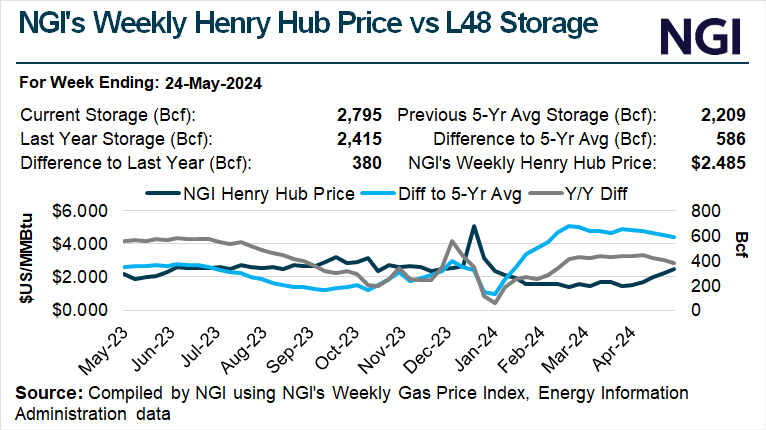The U.S. Energy Information Administration (EIA) on Thursday reported an 84 Bcf injection into natural gas storage for the week ended May 24. The print was above most expectations, but below historical averages.

Ahead of the 10:30 a.m. ET release, July futures were down 6.1 cents at $2.605/MMBtu. The prompt month was 6.6 cents lower when the EIA released the report. By 11 a.m. ET, it was 8.8 cents lower at $2.578.

The build marked the fifth straight lighter-than-average weekly injection. It reflected a rise in power demand as extreme heat moved into major consuming regions.
“It was warmer than normal over most of the country during the report week,” NatGasWeather meteorologist Rhett Milne said on the online energy platform Enelyst.
Leading up to the report, a Reuters survey of 12 analysts produced a 78 Bcf median injection, with responses ranging from 73 Bcf to 86 Bcf. Injection estimates submitted to Bloomberg ranged from 71 Bcf to 84 Bcf, with a 77 Bcf median. NGI modeled a spot-on 84 Bcf injection.
The five-year average for the period is a 104 Bcf build, while a 106 Bcf injection was recorded for the year-earlier period.
The increase from last week brought inventories to 2,795 Bcf, according to EIA. Stocks remained well above the year-ago level of 2,415 Bcf and the five-year average of 2,209 Bcf.
The East led with an injection of 27 Bcf. The Midwest showed a build of 24 Bcf. The South Central build of 16 Bcf included an 11 Bcf increase in nonsalt stocks and a bump of 5 Bcf in salts. EIA noted that totals do not always equal because of independent rounding.
The Mountain and Pacific regions each saw inventories rise by 8 Bcf.
Looking ahead, Milne said he expects the next two storage reports to print lighter than normal and drop surpluses toward 575 Bcf.
Early estimates for the week ending May 31 ranged from additions of 73 Bcf to 95 Bcf, with an average increase of 86 Bcf. That compares with an increase of 105 Bcf during the same week last year and a five-year average increase of 103 Bcf.
Further out, Milne said national demand should increase to stronger levels next week as most of the country warms to above normal.
Highs are forecast in the 80s over much of the Midwest, Ohio Valley, and East, while upper 80s to 100s are expected to the south. The hottest temperatures are forecast for the southwest deserts to West Texas, according to NatGasWeather.
Highs are forecast in the 80s over much of the Midwest, Ohio Valley, and East, while upper 80s to 100s are expected to the south. The hottest temperatures are forecast for the southwest deserts to West Texas, according to NatGasWeather.
Highs are forecast in the 80s over much of the Midwest, Ohio Valley, and East, while upper 80s to 100s are expected to the south. The hottest temperatures are forecast for the southwest deserts to West Texas, according to NatGasWeather.






